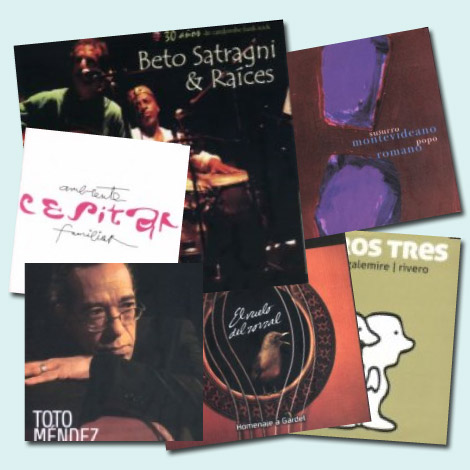In 1971 a group of people interested in our culture decided to found a record label in order to support musical expressions possessing artistic value. These were usually ignored, neglected or rejected by commercial record companies since they weren’t deemed a secure enough investment. Musicians Daniel Viglietti, José “Pepe” Guerra, Braulio López and Coriún Aharonián (the only founding member who is still active) were part of this original group. Also, Myriam Dibarboure, María Teresa Sande and Notary Public Edgardo Bello.
The names selected for the new institution were of Guarani origin. They entailed a very important symbolic significance to Uruguay’s short spanning history: Ayuí (name of the stream next to which General José Artigas -Uruguay’s national hero- established, in 1812, the country’s first government independent from Spaniard dominion), and Tacuabé (a chief from the Charrua indigenous nation, taken prisoner and sent to Paris to be exhibited as a curiosity until his death). Popular music, poetry and narrative materials were to be published under the Ayuí name; Tacuabé was the label intended for the broad scope of classical music. From the beginning the label was defined to develop a non-profit activity; all revenue obtained was to be fully applied to further production. This feature, strictly observed throughout all these years, has been one of the reasons for the survival of Ayuí/Tacuabé as a record/disc publishing company, and has enables the shaping and consolidation of its ample and independent catalog.
The very first publications set forth working guidelines that would prove innovative for the local milieu. Some of them were gradually adopted by other publishing labels, and eventually became a market standard. Records were numbered one by one (a procedure unique worldwide) as a way to guarantee the royalties to which musicians are entitled. Record jackets and all graphic design were entrusted to Uruguay’s first-rate plastic artists, designers and photographers. Vinyl record jackets were no longer regarded as mere packaging but as suitable surfaces to develop their art, binding it to the definitive recording project. Ayax Barnes created the Ayuí/Tacuabé logos, Nicolás Loureiro defined the overall graphic guidelines and Hermenegildo Sábat was entrusted with some of the initial jackets. Every title included extensive technical information, along with other data (like butterfly-shaped card with information on life spans of sapphire or diamond needles, which were part of a popular campaign designed to provide technical advice to users). The various technical phases in the process, which comprised printing as well as recording and manufacturing, included meticulous revision and repeated production tests aimed at achieving the desired quality level. In short each disc was considered an integral work of art, where quality was the objective all along.
Publications were grouped into series. Many of them still continue to be unique in the country: music for children, Uruguayan classical music, Latin-American new music, authors reading their texts, instrumental popular music.
The label was launched with the musical duet “Los Olimareños”, writers Juan Capagorry and Milton Schinca, humorist Wimpi, guitarist Agustín Carlevaro and composer Héctor Tosar, together with the first recording ever of a group of young singers who represented Cuba’s “Nueva Trova” (New Ballads). They were Silvio Rodríguez, Pablo Milanés and Noel Nicola, whose music was published in their homeland years after that. There were other examples of local first publications of good music from abroad, like that of Argentineans Juan Cedrón, Susana Rinaldi and Dina Rot, Chileans Ángel and Violeta Parra, Spaniards Paco Ibáñez and Raimón, the Old Music Ensemble from Munich, and the Cuban group “Bola de Nieve”, among others.

Listas de reproducción